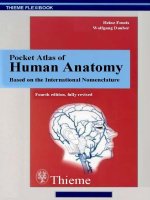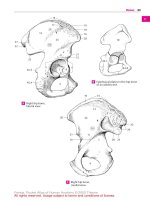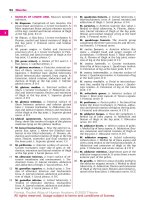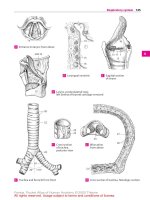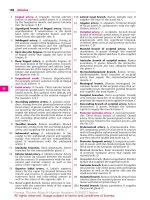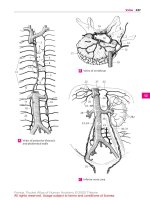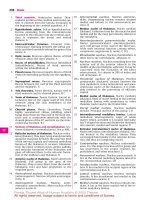Human anatomy ebook
Bạn đang xem bản rút gọn của tài liệu. Xem và tải ngay bản đầy đủ của tài liệu tại đây (4.73 MB, 169 trang )
NSC 102
HUMAN ANATOMY (I)
NATIONAL OPEN UNIVERSITY OF NIGERIA
SCHOOL OF HEALTH SCIENCES
COURSE CODE: NSC 102
COURSE TITLE: HUMAN ANATOMY I
COURSE UNITS: 5
NSC 102
HUMAN ANATOMY (I)
NATIONAL OPEN UNIVERSITY OF NIGERIA
COURSE GUIDE
NSC 102 – HUMAN ANATOMY I
COURSE CODE: NSC 102
COURSE TITLE: Human Anatomy I
COURSE UNITS: 5 Credit units (36 hours of instruction online; 12 hours of Discussion forum
online/tutorial; 48 hours of laboratory practical)
YEAR: 1
SEMESTER: 2nd Semester
PRE-REQUISITE COURSES: NONE; CON-CURRENT COURSES: NSc 104, 106, 108
SESSION: 2015/2016
COURSE WEBSITE: www.noun.edu.ng/
COURSE WRITERS
Dr. Adewole O.S. MBBS, PhD, (Associate Professor).
Dr. Abiodun A. O. MBBS, FWCS, M.Sc. (Senior Lecturer)
Dr. Ayannuga A. A. MBBS, Ph.D (Senior Lecturer)
Dr. Adeyemi D.A. PhD (Senior Lecturer)
Dr. Ojo S. K. MBChB, MSc (Lecturer II); Dr. Arayombo B. E. MBChB, MSc (Lecturer II)
Department of Anatomy and Cell Biology, College of Health Sciences, Obafemi Awolowo
University, Ile-Ife, Nigeria
Course Facilitators:
Dr. Adewole O.S. MBBS, PhD, (Associate Professor).
Dr. Arayombo B.E. MBChB, MSc (Lecturer II)
COURSE EDITORS: Dr O.O. Irinoye and Dr E.O Oladogba
PROGRAMME LEADER: Professor Mba Okoronkwo OON
COURSE COORDINATOR: As provided by the Department.
2
NSC 102
HUMAN ANATOMY (I)
Table of Contents
Page
Course Guide
General Introduction
Course Aims
Course Objectives
Working through the Course
Course Materials
Study Units
Reference Textbooks
Equipment and Software Needed to Access Course
Number and Places of Meeting
Discussion Forum
Course Evaluation
Grading Criteria
Grading Scale
Schedule of Assignments with Dates
Course Overview
How to get the most from this Course
4
4
4
4
5
5
6
6
6
7
7
7
7
7
8
8
3
NSC 102
HUMAN ANATOMY (I)
COURSE GUIDE
GENERAL INTRODUCTION
Hello, welcome to this course. We are happy to have you doing NSC 102 – Human Anatomy I.
You would have done some anatomy when you were in the basic school of nursing. You are
going to do a little more and have opportunities to have practical sessions to give you more
facts on the structure of the human body. Intrestingly, we all learn a lot from been able to look
at our own bodies too. As nurses you must know what the body is made off and how it
functions before you can determine if and when something goes wrong, what goes wrong and
what you can do within your professional responsibility to help clients achieve, maintain,
sustain, retain and adjust to permant change in the body. You can not practice safe without
sound knowledge of anatomy. Everything you have to do with the body of a patient requires
sound knowledge of anatomy for the patient to be safe with you in practice. Over a period of
three semesters, you are going to learn about the different organs that make up the human body.
This course along with the others must be learnt with your professional roles and duties in mind
at all times for you to also see how you can apply your new learning to improve your practice.
COURSE AIM.
The aim of this course is to build your foundation in the developmental process and the
structure of the human body as such prepares you to apply your knowledge in planning to meet
the care needs of your body and that of your clients as such may relate to normal and abnormal
changes in the various organs that make up the body.
COURSE OBJECTIVES
At the completion of this course, you should be able to:
i.
ii.
iii.
iv.
v.
Use anatomical terminology correctly.
Discuss the levels of organization of the human body.
Discuss the components of the body defense system
Discuss the human embryology from fertilization to birth
Discuss the two basic systems that provide support and movement for the human body.
COURSE IMPLEMENTATION – WORKING THROUGH THIS COURSE
The course will be delivered adopting the blended learning mode, 70% of online but interactive
sessions and 30% of face-to-face during laboratory sessions. You are expected to register for
this course online before you can have access to all the materials and have access to the class
sessions online. You will have the hard and soft copies of course materials, you will also have
online interactive sessions, face-to-face sessions with instructors during practical sessions in the
laboratory. The interactive online activities will be available to you on the course link on the
4
NSC 102
HUMAN ANATOMY (I)
Website of NOUN. There are activities and assignments online for every unit every week. It is
important that you visit the course sites weekly and do all assignments to meet deadlines and to
contribute to the topical issues that would be raised for everyone’s contribution.
You will be expected to read every module along with all assigned readings to prepare you to
have meaningful contributions to all sessions and to complete all activities. It is important that
you attempt all the Self Assessment Questions (SAQ) at the end of every unit to help your
understanding of the contents and to help you prepare for the in-course tests and the final
examination. You will also be expected to keep a portfolio where you keep all your completed
assignments.
COURSE MATERIALS
Course Guide
Course Text in Study Units
Textbooks (Hard and electronic)
Book of Laboratory Practical
Assignment File/Portfolio
STUDY UNITS
This course has three Modules and 13 units. They are structured as presented
Module 1
- Introduction to the Human body
Unit 1 General Body Organizations
Unit 2 Anatomical Terminology
Unit 3 Cells, Tissues, Organs, Systems & Membranes
Unit 4 Body Tissues
Unit 5 The Human Defense System
Module 2
Unit 1
Unit 2
Unit 3
Module 3
Unit 1
Unit 2
Unit 3
Unit 4
Unit 5
- Embryology
Embryology Terminology
Garmetogenesis
Placenta Formation and Functions
–
-
Support and Movement
Integumentary System
Skeletal System
Muscular system
Tendons and Ligaments
Joints and Bursae
5
NSC 102
HUMAN ANATOMY (I)
REFERENCE TEXTBOOKS
1. Sadler T.W (2004), Langman’s Medical Embryology 9th edition.
2. Philip Tate (2012) Seeley’s Principles of Anatomy & Physiology 2nd edition.
3. Katherine M. A. Rogers and William N. Scott (2011) Nurses! Test yourself in anatomy
and physiology
4. Kent M. Van De Graff, R.Ward Rhees, Sidney Palmer (2010) Schaum’s Outline of
Human Anatomy and Physiology 3rd edition.
5. Kathryn
A. Booth, Terri. D. Wyman (2008) Anatomy, physiology, and
pathophysiology for allied health
6. Keith L Moore, Persuade T.V.N (2006), The Developing Human Clinically Oriented
Embryology 8th Edition Lippincott Williams & Wilkins.
COURSE REQUIREMENTS AND EXPECTATIONS OF YOU
Attendance of 95% of all interactive sessions, submission of all assignments to meet deadlines;
participation in all CMA, attendance of all laboratory sessions with evidence as provided in the
log book, submission of reports from all laboratory practical sessions and attendance of the
final course examination. You are also expected to:
1.
2.
3.
4.
Be versatile in basic computer skills
Participate in all laboratory practical up to 90% of the time
Submit personal reports from laboratory practical sessions on schedule
Log in to the class online discussion board at least once a week and contribute to
ongoing discussions.
5. Contribute actively to group seminar presentations.
EQUIPMENT AND SOFTWARE NEEDED TO ACCESS COURSE
You will be expected to have the following tools:
1.
2.
3.
4.
5.
A computer (laptop or desktop or a tablet)
Internet access, preferably broadband rather than dial-up access
MS Office software – Word PROCESSOR, Powerpoint, Spreadsheet
Browser – Preferably Internet Explorer, Moxilla Firefox
Adobe Acrobat Reader
NUMBER AND PLACES OF MEETING (ONLINE, FACE-TO-FACE, LABORATORY
PRACTICALS)
The details of these will be provided to you at the time of commencement of this course
DISCUSSION FORUM
There will be an online discussion forum and topics for discussion will be available for your
contributions. It is mandatory that you participate in every discussion every week. You
6
NSC 102
HUMAN ANATOMY (I)
participation link you, your face, your ideas and views to that of every member of the class and
earns you some mark.
COURSE EVALUATION
There are two forms of evaluation of the progress you are making in this course. The first are
the series of activities, assignments and end of unit, computer or tutor marked assignments, and
laboratory practical sessions and report that constitute the continuous assessment that all carry
30% of the total mark. The second is a written examination with multiple choice, short answers
and essay questions that take 70% of the total mark that you will do on completion of the
course.
Students evaluation: The students will be assessed and evaluated based on the following criteria
o In-Course Examination:
In-course examination will come up in the middle of the semester. These would come in
form of Computer Marked Assignment. This will be in addition to one compulsory
Tutor Marked Assignment (TMA’s) and three Computer marked Assignment that comes
after the modules.
o Laboratory practical: Attendance, record of participation and other assignments will
be graded and added to the other scores from other forms of examinations.
o Final Examination: The final written examination will come up at the end of the
semester comprising essay and objective questions covering all the contents covered in
the course. The final examination will amount to 60% of the total grade for the course.
Learner-Facilitator evaluation of the course
This will be done through group review, written assessment of learning (theory and laboratory
practical) by you and the facilitators.
GRADING CRITERIA
Grades will be based on the following Percentages
Tutor Marked Individual Assignments
10%
Computer marked Assignment
10%
Group assignment
5%
Discussion Topic participation
5%
Laboratory practical
10%
30%
7
NSC 102
End of Course examination
HUMAN ANATOMY (I)
70%
GRADING SCALE
A = 70-100
B = 60 - 69
C= 50 - 59
F = < 49
SCHEDULE OF ASSIGNMENTS WITH DATES
Every Unit has activity that must be done by you as spelt out in your course materials. In
addition to this, specific assignment will also be provided for each module by the facilitator.
SPECIFIC READING ASSIGNMENTS
To be provided by each module
COURSE OVERVIEW
Human Anatomy (I)
Human Anatomy is a basic life science that helps us learn about the body structure. This course
examines the body organization, anatomical terminology, cells, tissues, organs, systems,
membranes, body tissues, the human defense system, embryology terminology, garmetogenesis,
placenta formation and functions, intergumentary, skeletal and muscular systems. The course
has the theory and laboratory components that spread over 15 weeks. The course is presented in
Modules with small units. Each unit is presented to follow the same pattern that guides your
learning. Each module and unit have the learning objectives that helps you track what to learn
and what you should be able to do after completion. Small units of contents will be presented
every week with guidelines of what you should do to enhance knowledge retention as had been
laid out in the course materials. Practical sessions will be negotiated online with you as
desirable with information about venue, date and title of practical session.
HOW TO GET THE MOST FROM THIS COURSE
1. Read and understand the context of this course by reading through this course guide
paying attention to details. You must know the requirements before you will do well.
2. Develop a study plan for yourself.
8
NSC 102
HUMAN ANATOMY (I)
3. Follow instructions about registration and master expectations in terms of reading,
participation in discussion forum, end of unit and module assignments, laboratory
practical and other directives given by the course coordinator, facilitators and tutors.
4. Read your course texts and other reference textbooks.
5. Listen to audio files, watch the video clips and consult websites when given.
6. Participate actively in online discussion forum and make sure you are in touch with your
study group and your course coordinator.
7. Submit your assignments as at when due.
8. Work ahead of the interactive sessions.
9. Work through your assignments when returned to you and do not wait until when
examination is approaching before resolving any challenge you have with any unit or
any topic.
10. Keep in touch with your study centre, the NOUN, School of Health Sciences websites as
information will be provided continuously on these sites.
11. Be optimistic about doing well.
9
NSC 102
HUMAN ANATOMY (I)
COURSE TEXT/MATERIAL
Table of Contents
Page
Human Anatomy I
Module 1
- Introduction to the Human body
10
Unit 1 -
General Body Organizations
10
Unit 2 -
Anatomical Terminology
18
Unit 3 -
Cells, Tissues, Organs, Systems & Membranes
26
Unit 4 -
Body Tissues
42
Unit 5 -
The Human Defense System
60
Module 2
- Embryology
72
Unit 1
-
Embryology Terminology
72
Unit 2
-
Garmetogenesis
76
Unit 3
-
Placenta Formation and Functions
Module 3
–
Support and Movement
98
Unit 1
-
Integumentary System
98
Unit 2
-
Skeletal System
109
Unit 3
-
Muscular system
129
Unit 4
-
Tendons and Ligaments
147
Unit 5
-
Joints and Bursae
152
10
NSC 102
Module 1
-
HUMAN ANATOMY (I)
Introduction to the Human body
Although the primary concern of anatomy is with structure, structure and function should be
considered together. Many times, a student first realizes the importance of human anatomy only
when brought to the bedside or the operating table of his/her patient, when the first thing he/she
is faced with is the least he has considered. Anatomy is the science of the structure of the body.
In relation to the size of the parts studied, anatomy is usually divided into (1) macroscopic or
gross anatomy, and (2) microscopic anatomy or histology (now used synonymously). In
addition, embryology is the study of the embryo and the fetus, that is, the study of prenatal
development, whereas the study of congenital malformations is known as teratology.
At the end of this module, you should be able to:
i.
ii.
iii.
Use anatomical terminology correctly.
Discuss the levels of organization of the human body.
Discuss the components of the body defense system
CONTENTS
Unit 1:
Unit 2:
Unit 3:
Unit 4:
Unit 5:
General Body Organizations
Anatomical Terminology
Cells, Tissues, & Membranes
Body Tissues
The Human Defense System
UNIT ONE: GENERAL BODY ORGANIZATION
CONTENT
1.0
Introduction
2.0
Objectives
3.0
Contents
3.1
Structures of the human body
3.2
Body functions
3.3
Characteristics of life
4.0
Conclusion
5.0
Summary
6.0
Tutor Marked Assignments
6.1
Activity
6.2
Tutor Marked Tests
7.0
Reference and other resources
11
NSC 102
1.0
HUMAN ANATOMY (I)
Introduction
In general, works dealing with human anatomy are arranged either (1) systemically, that is,
according to the various systems of the body (skeletal, muscular, digestive, etc.) or (2)
regionally, that is, according to the natural, main subdivisions of the body (head and neck,
upper and lower limbs, thorax, etc.). In this write up, the general features of certain systems will
be discussed, chiefly because the vast majority of laboratory courses in human anatomy are
based on systems.
Human beings are arguably the most complex organisms on this planet. Imagine billions of
microscopic parts, each with its own identity, working together in an organized manner for the
benefit of the total being. The human body is a single structure but it is made up of billions of
smaller structures of four major kinds, such as Cells, Tissues, Organs and Systems: CellsTissues-Organs-Systems
2.0
Objectives
At the end of this unit, you will be able to:
i.
ii.
3.0
Describe how the body is organized from simple to more complex levels.
Explain the characteristics of life exhibited by human being.xhibit the characteristics of
life.
Main Content
3.1 Structures of the human body
I.
Cells
The cell is the basic living unit of all organisms. The simplest organisms consist of single cells.
It is estimated that humans are composed of 10 to 100 trillion cells. An average-sized cell is
one-fi fth the size of the smallest dot you can make on a sheet of paper with a sharp pencil. If
each cell of the body were the size of a standard brick, the colossal human statue made from
those bricks would be 6 miles high!
Light microscopes allow us to visualize general features of cells Cells have long been
recognized as the simplest units of living matter that can maintain life and reproduce
themselves. Cells are the basic structural and functional units of the human body and there are
many different types of cells (e.g., muscle, nerve, blood, and so on)
12
NSC 102
II.
HUMAN ANATOMY (I)
Tissues
Tissues are somewhat more complex units than cells. A tissue is an organization of a great
many similar cells that perform a specific function with varying amounts and kinds of
nonliving, intercellular substance between them. The basic types of tissues in the human body
include epithelial, muscle, nervous, and connective tissues
13
NSC 102
III.
HUMAN ANATOMY (I)
Organs
An organ consists of 2 or more tissues that perform a particular function (e.g., heart, liver,
stomach, and so on). It is an organ is an organization of several different kinds of tissues so
arranged that together they can perform a special function. For example, the stomach is an
organization of muscle, connective, epithelial, and nervous tissues. Muscle and connective
tissues form its wall, epithelial and connective tissues form its lining, and nervous tissue
extends throughout both its wall and its lining.
IV.
Systems
An association of organs that have a common function; there are 11 major systems in the
human body, including digestive, nervous, endocrine, circulatory, respiratory, urinary,
reproductive, muscular, lymphatic, skeletal, and integumentary. Systems are the most complex
of the component units of the human body. (MIS CRUNDLER… M-muscular I-integumentary
S-Skeletal C-circulatory R-respiratory U-urinary N-nervous D-digestive L-lymphatic Eendocrine R-reproductive).
3.2
Body functions
Body functions are the physiological or psychological functions of body systems. The body's
functions are ultimately its cells' functions. Survival is the body's most important business.
Survival depends on the body's maintaining or restoring homeostasis, a state of relative
constancy, of its internal environment.
More than a century ago, French physiologist, Claude Bernard (1813-1878), made a remarkable
observation. He noted that body cells survived in a healthy condition only when the
temperature, pressure, and chemical composition of their environment remained relatively
constant. Later, an American physiologist, Walter B. Cannon (1871-1945), suggested the name
homeostasis for the relatively constant states maintained by the body. Homeostasis is a key
word in modern physiology. It comes from two Greek words - "homeo," meaning the same, and
"stasis," meaning standing. "Standing or staying the same" then is the literal meaning of
homeostasis. However, as Cannon emphasized, homeostasis does not mean something set and
immobile that stays exactly the same all the time. In his words, homeostasis "means a condition
that may vary, but which is relatively constant."
Homeostasis depends on the body's ceaselessly carrying on many activities. Its major activities
or functions are responding to changes in the body's environment, exchanging materials
between the environment and cells, metabolizing foods, and integrating all of the body's diverse
activities. The body's ability to perform many of its functions changes gradually over the years.
In general, the body performs its functions least well at both ends of life - in infancy and in old
age. During childhood, body functions gradually become more and more efficient and effective.
During late maturity and old age the opposite is true. They gradually become less and less
efficient and effective. During young adulthood, they normally operate with maximum
efficiency and effectiveness.
14
NSC 102
3.3
HUMAN ANATOMY (I)
Characteristics of life
All living organisms have certain characteristics that distinguish them from non-living forms:
(MR NIGER D) The basic processes of life include organization, metabolism,
responsiveness, movements, and reproduction. In humans, who represent the most complex
form of life, there are additional requirements such as growth, differentiation, respiration,
digestion, and excretion. All of these processes are interrelated. No part of the body, from the
smallest cell to a complete body system, works in isolation. All function together, in fine-tuned
balance, for the well being of the individual and to maintain life. Disease such as cancer and
death represent a disruption of the balance in these processes.
The following are a brief description of the life process:
Organization
At all levels of the organizational scheme, there is a division of labor. Each component has its
own job to perform in cooperation with others. Even a single cell, if it loses its integrity or
organization, will die.
Atoms Molecules Macromolecules Organelles Cells Tissues Organ Organ
Systems Organism
Metabolism
Metabolism is a broad term that includes all the chemical reactions that occur in the body. One
phase of metabolism is catabolism in which complex substances are broken down into simpler
building blocks and energy is released. Needs: Water, food, oxygen, heat, pressure - all must
be regulated, the other phase is anabolism; which involves construction of complex substances
from simpler ones
Responsiveness
Responsiveness or irritability is concerned with detecting changes in the internal or external
environments and reacting to that change. It is the act of sensing a stimulus and responding to
it.
Movement
There are many types of movement within the body. On the cellular level, molecules move
from one place to another. Blood moves from one part of the body to another. The diaphragm
moves with every breath. The ability of muscle fibers to shorten and thus to produce movement
is called contractility.
Reproduction
For most people, reproduction refers to the formation of a new person, the birth of a baby. In
this way, life is transmitted from one generation to the next through reproduction of the
organism. In a broader sense, reproduction also refers to the formation of new cells for the
replacement and repair of old cells as well as for growth. This is cellular reproduction. Both are
essential to the survival of the human race.
15
NSC 102
HUMAN ANATOMY (I)
Growth
Growth refers to an increase in size either through an increase in the number of cells or through
an increase in the size of each individual cell. In order for growth to occur, anabolic processes
must occur at a faster rate than catabolic processes.
Differentiation
Differentiation is a developmental process by which unspecialized cells change into specialized
cells with distinctive structural and functional characteristics. Through differentiation, cells
develop into tissues and organs.
Respiration
Respiration refers to all the processes involved in the exchange of oxygen and carbon dioxide
between the cells and the external environment. It includes ventilation, the diffusion of oxygen
and carbon dioxide, and the transport of the gases in the blood. Cellular respiration deals with
the cell's utilization of oxygen and release of carbon dioxide in its metabolism.
Digestion
Digestion is the process of breaking down complex ingested foods into simple molecules that
can be absorbed into the blood and utilized by the body.
Excretion
Excretion is the process that removes the waste products of digestion and metabolism from the
body. It gets rid of by-products that the body is unable to use, many of which are toxic and
incompatible with life.
The ten life processes described above are not enough to ensure the survival of the individual.
In addition to these processes, life depends on certain physical factors from the environment.
These include water, oxygen, nutrients, heat, and pressure.
4.0
Conclusion
The body is made of structures organized from simple to complex at six levels with 11 organsystems.
5.0
i.
ii.
iii.
iv.
Summary: In this unit, you have learnt:
Anatomy is the study of the structure of the human body
Systemic anatomy is the study of the body by organ systems. Regional anatomy is the
study of the body by areas.
Surface anatomy uses superficial structures to locate deeper structures, and anatomical
imaging is a non-invasive method for examining deep structures.
The human body can be organized into six levels: chemical (atoms and molecules), cell,
tissue (groups of similar cells and the materials surrounding them), organ (two or more
tissues that perform one or more common functions), organ system (groups of organs
with common functions), and organism.
16
NSC 102
v.
vi.
HUMAN ANATOMY (I)
The 11 organ systems are the integumentary, skeletal, muscular, nervous, endocrine,
cardiovascular, lymphatic, respiratory, digestive, urinary, and reproductive systems.
The characteristics of life include organization, metabolism, responsiveness, growth,
development, and reproduction.
6.0
Tutor Marked Assignments
6.1
Look at the differences between the cell and tissue under the microscope at the
Histology and report your findings in your log book.
6.2
Answer the following questions:
1. From smallest to largest, list and define the body’s six levels of organization.
2. What are the four primary tissue types?
3. Which two organ systems are responsible for regulating the other organ systems?
4. Which two are responsible for support and movement?
5. What are the functions of the integumentary, cardiovascular, lymphatic, respiratory,
digestive, urinary, and reproductive systems?
6. Describe six characteristics of life.
7. Why is it important to realize that humans share many, but not all, characteristics with
other animals?
8. The following are organizational levels for considering the body.
a. cell
b. chemical
c. organ
d. organ system,
e. organism
f. tissue
8. Choose the correct order for these organizational levels from smallest to largest.
a. 1,2,3,6,4,5
b. 2,1,6,3,4,5
c. 3,1,6,4,5,2
d. 2,6,1,3,5,4
e. 1,6,5,3,4,2
7.0
References and other resources
17
NSC 102
HUMAN ANATOMY (I)
UNIT TWO: ANATOMICAL TERMINOLOGY
CONTENT
1.0
2.0
3.0
3.1
3.2
3.3
3.4
4.0
5.0
6.0
6.1
6.2
7.0
Introduction
Objectives
Main Content
Directional terms
Planes of the body
Body cavities
Clinical correlates
Conclusion
Summary
Tutor Marked Assignments
Activity
Teacher Marked Tests
References and other resources
1.0 Introduction
Before we get into the following learning units, which will provide more detailed discussion of
topics on different human body systems, it is necessary to learn some useful terms for
describing body structure. Knowing these terms will make it much easier for us to understand
the content of the following learning units. Three groups of terms are introduced here:
Directional Terms
Planes of the Body
Body Cavities
2.0 Objectives
At the end of this unit, you will be able to:
i.
ii.
iii.
3.0
Describe the anatomical position.
Identify the planes of reference used to locate and describe structures within the body.
Identify and to locate the principal body cavities and the organs within them.
Main Content
3.1
Directional terms
Directional terms describe the positions of structures relative to other structures or locations in
the body.
18
NSC 102
HUMAN ANATOMY (I)
Superior or cranial - toward the head end of the body; upper (example, the hand is part of the
superior extremity).
Inferior or caudal - away from the head; lower (example, the foot is part of the inferior
extremity).
Anterior or ventral - front (example, the kneecap is located on the anterior side of the leg).
Posterior or dorsal - back (example, the shoulder blades are located on the posterior side of
the body).
Medial - toward the midline of the body (example, the middle toe is located at the medial side
of the foot).
Lateral - away from the midline of the body (example, the little toe is located at the lateral side
of the foot).
Proximal - toward or nearest the trunk or the point of origin of a part (example, the proximal
end of the femur joins with the pelvic bone).
Distal - away from or farthest from the trunk or the point or origin of a part (example, the hand
is located at the distal end of the forearm).
19
NSC 102
HUMAN ANATOMY (I)
3.2 Planes of the body
Coronal Plane (Frontal Plane) - A vertical plane running from side to side; divides the body
or any of its parts into anterior and posterior portions.
Sagittal Plane (Lateral Plane) - A vertical plane running from front to back; divides the body
or any of its parts into right and left sides.
Axial Plane (Transverse Plane) - A horizontal plane; divides the body or any of its parts into
upper and lower parts.
Median plane - Sagittal plane through the midline of the body; divides the body or any of its
parts into right and left halves.
20
NSC 102
HUMAN ANATOMY (I)
3.3 Body cavities
The cavities, or spaces, of the body contain the internal organs, or viscera. The two main
cavities are called the ventral and dorsal cavities. The ventral is the larger cavity and is
subdivided into two parts (thoracic and abdominopelvic cavities) by the diaphragm, a domeshaped respiratory muscle.
21
NSC 102
HUMAN ANATOMY (I)
Thoracic cavity
The upper ventral, thoracic, or chest cavity contains the heart, lungs, trachea, esophagus, large
blood vessels, and nerves. The thoracic cavity is bound laterally by the ribs (covered by costal
pleura) and the diaphragm caudally (covered by diaphragmatic pleura).
Abdominal and pelvic cavity
The lower part of the ventral (abdominopelvic) cavity can be further divided into two portions:
abdominal portion and pelvic portion. The abdominal cavity contains most of the
gastrointestinal tract as well as the kidneys and adrenal glands. The abdominal cavity is bound
cranially by the diaphragm, laterally by the body wall, and caudally by the pelvic cavity. The
pelvic cavity contains most of the urogenital system as well as the rectum. The pelvic cavity is
bounded cranially by the abdominal cavity, dorsally by the sacrum, and laterally by the pelvis.
Dorsal cavity
The smaller of the two main cavities is called the dorsal cavity. As its name implies, it contains
organs lying more posterior in the body. The dorsal cavity, again, can be divided into two
portions. The upper portion, or the cranial cavity, houses the brain, and the lower portion, or
vertebral canal houses the spinal cord
3.4 Clinical correlates
The serous membranes can become inflamed—usually as a result of an infection. Pericarditis is
inflammation of the pericardium, pleurisy is inflammation of the pleura, and peritonitis is
inflammation of the peritoneum. Visceral peritoneum covers the appendix, which is a small,
wormlike sac attached to the large intestine. An infection of the appendix can rupture its wall,
releasing bacteria into the peritoneal cavity, resulting in peritonitis. Appendicitis is the most
common cause of emergency abdominal surgery in children and it often leads to peritonitis.
22
NSC 102
HUMAN ANATOMY (I)
4.0
Conclusion
The body can be described from the perspective of directions or along the planes. The body also
can has different cavities that contain different organs in the body.
5.0 Summary: In this unit, you have learnt that:
i.
ii.
iii.
iv.
v.
vi.
vii.
viii.
The human body is a single structure but it is made up of billions of smaller structures of
four major kinds: cells, tissues, organs and systems.
An organ is an organization of several different kinds of tissues so arranged that together
they can perform a special function
A system is an organization of varying numbers and kinds of organs so arranged that
together they can perform complex functions for the body.
Ten major systems include the skeletal, muscular, nervous, endocrine, cardiovascular,
lymphatic, respiratory, digestive, urinary, and the reproductive systems.
Body functions are the physiological or psychological functions of body systems.
Survival of the body depends on the body’s maintaining or restoring homeostasis, a state
of relative constancy, of its internal environment.
Human life process includes organization, metabolism, responsiveness, movements,
reproduction, growth, differentiation, respiration, digestion, and excretion. All these
processes work together, in fine- tuned balance, for the well – being of the individual
and to maintain life.
Life depends on certain physical factors from the environment, which include water,
oxygen, nutrients, heat, and pressure.
Terms used in describing body parts and activities include – directional terms, terms
used in describing body planes and body cavities.
6.0
Tutor Marked Assignments
6.1
At the gross anatomy laboratory, identify the different cavities of the body and the
contents of each cavity in relation to one another with directional terms and report in
your log book.
6.2
Answer all these questions.
1. The clavicle (collarbone) is to the nipple of the breast.
a. anterior
b. distal
c. superficial
d. superior
e. ventral
2. The term that means nearer to the attached end of a limb is
a. distal
b. lateral..
c. medial.
d. proximal
23
NSC 102
HUMAN ANATOMY (I)
3. Which of these directional terms are paired most appropriately as opposites?
a. superficial and deep
b. medial and proximal
c. distal and lateral
d. superior and posterior
e. anterior and inferior
4. The part of the upper limb between the elbow and the wrist is called the
a. arm..
b. forearm.
c. hand.
d. inferior arm quadrant of the abdomen.
e. lower arm
5. A patient with appendicitis usually has pain in the
a. left-lower
b. right-lower
c. left-upper
d. right-upper
6. A plane that divides the body into anterior and posterior parts is a
a. frontal (coronal) plane.
b. sagittal plane.
c. transverse plane.
7. The word “homeostasis” is derived from:
a. Greek
b. Latin
c. Sanskrit
d. German
7. One phase of metabolism is in which complex substances are broken down into
simpler building blocks and energy is released
a. Organization
b. Responsiveness
c. Catabolism
d. Growth
8. With reference to the planes of the body, discuss the advantage of computed
tomography (CT or CAT) scans and magnetic resonance images (MRIs) over
conventional x-rays.
10. What are visceral organs?
7.0 References and other resources: As provided by the Instructor.
24
NSC 102
UNIT THREE:
HUMAN ANATOMY (I)
CELLS, TISSUES, & MEMBRANES
CONTENT
1.0
2.0
3.0
3.1
3.2
3.3
3.4
3.5
4.0
5.0
6.0
6.1
6.2
7.0
Introduction
Objectives
Main Content
Cell theory
Cell structure and function
Cell division
DNA replication and protein synthesis
Clinical correlates
Conclusion
Summary
Tutor Marked Assignments
Activity
Tutor Marked Tests
References and other resources
1.0
Introduction
This section provides detailed information about cell structure and function, four basic types of
tissue in the human body, and the different types of membranes found in the body.
2.0
Objectives
At the end of this unit, you should be able to:
i.
ii.
iii.
iv.
v.
3.0
Discuss the cell theory
Explain the cellular organization of the human body.
Discuss the types and functions of the various body membranes
Discuss the importance of cell division in the human body.
Explain the processes of replication, transcription, and translation.
Main Content
3.1 Cell theory
Important Events in the Discovery of Cells
1665 - Robert Hooke looks at cork under a microscope. Calls the chambers he see
"cells"
1665 - 75 Anton van Leeuwenhoek, the person incorrectly given credit for the invention
of the microscope (actually, he was just damn good at making and using them, and his
scopes soon became the standard, and history has just given him credit as the inventor of
25

